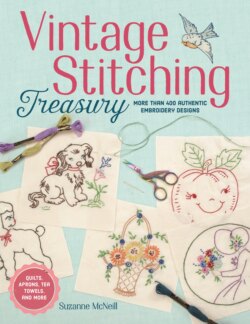Читать книгу Vintage Stitching Treasury - Suzanne McNeill - Страница 5
На сайте Литреса книга снята с продажи.
Оглавление3
Vintage Stitching Treasury
1880–1900
Realistic or naturalistic renderings. Visual puns and symbolic messages common.
“Talking” linens with greetings or jokes. Novelty work done in strong, natural colors. Fine
embroidery used for better quality decorative purposes—eyeletting, padded satin stitch, etc.
Turkey work/redwork a popular trend, where patterns for Kensington stitch (needlepainting)
are done in outlining only, in Turkey Red. First iron-on transfers appear on the market.
Bonanza of easily available flosses, fabrics, and patterns suddenly becomes available.
1900–1910
Arts & Crafts style patterns are a special niche in the kit and pattern market. Simplified natural
forms (flowers and abstract forms) often combine some very curvilinear elements of art
nouveau. Many kits pre-tinted to show elaborate stitching plans. This tinting is often simply
outlined and left to be enjoyed on its own.
1900–1920
Novelty patterns become increasingly professional looking. Novelty motifs continue
to be increasingly realistic. Fine embroidery motifs continue in eyeletting and other
traditional methods.
1920s
Kits for embroidered everything, from clothes to umbrella holders, are available. Incredible
number of patterns published. It’s a golden era for art embroidery. Linens feature unusually
shaped edges and corners, often fitting tightly to motifs. Colonial Lady themes begin
popularity. There is increasing whimsy and stylization in many designs. Black highlights and
accents are common in light pastel color schemes. Tinting becomes increasingly common in
combination with embroidery.
1930s
Patterns are highly professional, standardized. Motifs tend toward lush shapes, colors, or
backgrounds. Boudoir pillows, potholders, and Day of the Week towels become increasingly
popular. Novelty dolls, pajama bags, and other objects combine tinting, sewing, and
embroidery. Styles are influenced by Art Deco—strong shapes and luxurious colors. Black is
used as a background color for a stark, rich effect.
1940s
War-conscious patterns appear, including stuffed soldier dolls and motifs of soldiers with girls,
etc. Patterns take on slightly cartooned features, such as chipmunk cheeks and especially
large eyes, on a consistent basis, similar to other cartoon artwork of the period. Variety of
shapes in linens decreases, leading to less complex hems and finishing. Period details are
commonly used to add life to patterns. Increasingly refined patterns mimic the real world, but
always as a caricature.
1950s
Patterns move from being highly rendered to being occasionally over-rendered (action lines,
etc.) and complicated. Period details are no longer found. There are fewer pattern publishers
to choose from. Elaborately feminine designs feature figures and lines consistent with the
elegant fashions of the times.
Embroidery Styles Through the Years
Here’s a tip-of-the iceberg, seat-of-your-pants synopsis of the basic trends of
art embroidery patterns, almost 100 years in less than 500 words!
